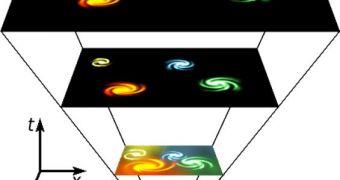In spite of the fact that today's supercomputers are highly advanced and capable of billions of operations per second, they still have difficulties in handling complex tasks such as modeling the Big Bang. However, this line of research is absolutely fundamental to understanding our place and origin in the Universe. Researchers at the Southern Methodist University (SMU) have recently developed a new mathematical model that is meant to help computers get a firmer grasp of the issues they simulate.
While the history of the Universe is relatively well established, or at least largely agreed upon, a consensus has yet to form over what happened during the Big Bang, and also in the first moments afterwards. Astrophysicists are extremely interested in the series of processes and events that eventually led to cosmic gas and dust forming planets, stars, galaxies, black holes and other celestial objects. What exactly influenced these extremely fast processes in taking place is still an unanswered question.
The goal of the new model is to help astronomers understand precisely what happened during the Reionization Epoch, a time frame spanning between 380,000 years and 400 million years after the Universe was formed. The work was conducted by SMU Assistant Professor of Mathematics Daniel Reynolds, who collaborated closely with University of California in San Diego (UCSD) astrophysicists on the research. The US National Science Foundation (NSF) provided the funding necessary for the investigation effort.
The first models of the Cosmos' Dark Ages were ran on the Ranger (University of Texas in Austin) and Kraken (University of Tennessee) supercomputers. These are two of the most powerful such machines owned by the NSF. Some of the processes and events that were inserted in the model included gas motions, gravitational acceleration, dark matter dynamics, radiation transport and chemical kinetics. What sets this model apart from other simulations is the fact that the focus was placed on enforcing a very tight coupling between the various physical processes that were embedded in it.
“By forcing the computational methods to tightly bind these processes together, our new model allows us to generate simulations that are highly accurate, numerically stable and computationally scalable to the largest supercomputers available,” Reynolds explains. His work was published in a recent issue of the respected Journal of Computational Physics, in a paper entitled “Self-Consistent Solution of Cosmological Radiation-Hydrodynamics and Chemical Ionization.”

 14 DAY TRIAL //
14 DAY TRIAL //